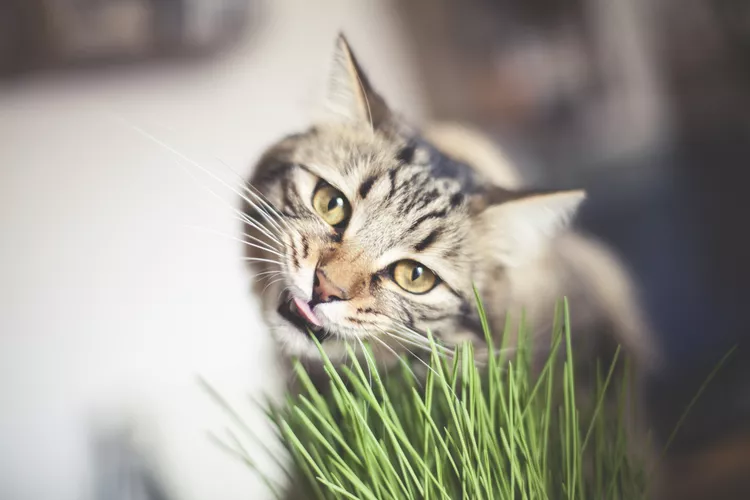Why Do Cats Like Cat Grass?

Anyone with a green thumb and a cat knows that cats like to investigate plants. They will even nibble or eat some plants, such as cat grass. What exactly is cat grass and why do cats love it so much?
What Is Cat Grass?
Some may think that cat grass is the same thing as catnip and catmint. Cat grass is actually not the same thing, though. Catnip and catmint are plants that belong to the mint family. Catnip sometimes is used as a catch-all term that includes catmint, but they are actually two separate species within the same genus, Nepeta. Although they may look similar, cats tend to react less to catmint than they do to catnip.
Cat grass is something else entirely. If you grow catnip and cat grass, you can appreciate this in the different appearance of the plants themselves. Cat grass is actually the grass of certain cereal grains such as wheat, oat, barley, alfalfa, and rye.
Why Do Cats Like Cat Grass?
It’s still unclear why cats like to nibble on any grass, including cat grass, though there has been some research as to the reasoning. It was once believed that cats ate grass when they were feeling ill, as a way to settle their stomach. However, a study has brought this into question. A group of cat owners were surveyed and of the respondents, 65% of cats ate plants on a weekly basis. Only 6% of these were described by their owner as being ill before munching on the plant and 37% were reported to have frequent vomiting afterwards. This would infer that cats don’t actually eat plants, including cat grass, in order to feel better because 94% of the cats in the survey were seemingly fine before eating anything. Another hypothesis as to why cats eat cat grass is to help expel hairballs. If eating grass makes a cat vomit, would it help a longhaired cat struggling to cough up a hairball? The same study that looked at whether cats ate grass to settle their stomach also looked at this notion. They found, however, that there was no difference in incidence of vomiting between longhaired cats and shorthaired cats.
There is thinking around the idea that eating grass might be a way to control and excrete intestinal parasites. A Belgian study looked at various wild carnivores, including various Canidae species but also various wildcats, including lynx, cougars, pumas, and leopards. This study showed that even wild cats ate grasses, showing this was not just a domestic cat behavior and is likely a natural behavior among all cats.
Where Can You Purchase Cat Grass?
Cat grass is actually relatively easy to find. Some pet supply stores may have small trays of it for sale, but you can also find it at nurseries. Remember, cat grass can be wheat, barley, alfalfa, or rye, so you may see it advertised as "wheat grass," etc. You can also purchase seed packets to grow your own cat grass. Again, these may not be marketed as cat grass seeds but wheat, barley, alfalfa, or rye grass.
Where Can You Plant Cat Grass?
Cat grass can be grown indoors in a container or in your outdoor garden. If growing outdoors, you can either plant the seeds directly in the soil or transplant an already thriving bunch of cat grass from a container to the soil. If you’re growing indoors, the seeds can be sown anytime of year. They should be sown 1/4” deep into the soil and the soil should be kept moist. After a week or two the seedlings should start to emerge. At this point, keep them in a spot that will get lots of regular sunshine. Cat grass planted outdoors should be planted in the spring and get full sun.
Why Is It Better For Cats to Eat Cat Grass Than Regular Grass?
Cat grass is a better option for your cat to nibble on than lawn grass for a few reasons. If you use any pesticides to treat your lawn, there are health risks to your cats if they were to inadvertently ingest them. Nibbling on lawn grass can also put your cat at risk of ingesting parasites and/or encountering fleas and ticks. Of course, this could also be the case if your cat nibbles on cat grass or anything else out in your yard. Instead of letting your cat eat plants out in the yard, take clippings and thoroughly wash them before giving them to your cat, or plant a small amount of cat grass indoors for your cat to enjoy.
It’s still unclear why cats like to eat cat grass, but it’s relatively safe for them to do so. It can be another piece of enrichment in their home.